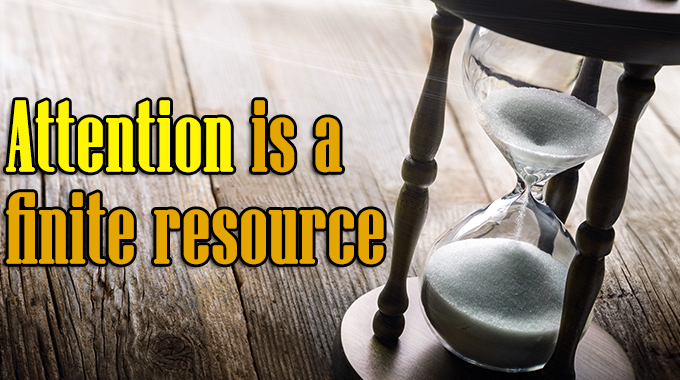Attention is a finite resource

When people visit New York City for the first time, they are often wowed by Times Square. It’s big, bright, flashy and intense. All of the lights and sounds that emanate from the screens and billboards are in-your-face and captivating. To people who live in New York, however, Times Square is just another neighborhood with crowds, traffic and noise. New Yorkers are used to the ads, they’re used to the noise and they’re used to the flashiness. Because they’re so used to it, they tune it out.
A similar problem faces the digital marketing industry today. People have become so used to having ads plastered all over the Web that they don’t give them the benefit of their attention. Many marketers still think that the best way to capture a consumer’s attention is to just get their ad in front of them, even if it’s contextually irrelevant. But attention is a finite resource. If you don’t treat it wisely, it will disappear.
Recent news and trends reveal that this resource is increasingly endangered today. According to a recent survey by Microsoft, the average human’s attention span has decreased from 12 seconds to eight secondssince the turn of the millennium. Banner blindness, a trend whereby amajority of consumers unconsciously ignore banner ads, is making that format increasingly ineffective. Similarly, content blindness, whereby consumers are so inundated with different types of content that they similarly no longer see what’s in front of them, is hitting content marketing and native advertising in particular. It’s no surprise, considering that 60 percent of marketers, company execs, and millennials surveyed recently byThe Economist said they would ignore content that sounds like it’s trying to sell something.
Most of these examples are happening unconsciously, making them tough nuts to crack, but we’re also seeing conscious consumer efforts to reduce the amount of marketing content coming their way, most notably with theincreased adoption of ad-blocking software.
In this case, however, the findings are encouraging for marketers: a full 80 percent of ad blocker users confess that website usability is the reason they’re blocking ads. In other words, it’s not that they necessarily want an ad-free experience, they just don’t want ads that attempt to forcibly take their attention and bog down the speed of site loads.
To win back consumer attention ads need to be more connected with and relevant to the content they are served alongside, creating a more fluid user experience in the process. A person browsing through film reviews on Rotten Tomatoes isn’t likely to suddenly devote their attention to an ad about furniture because it’s completely unrelated to movies. An ad for a streaming movie service, however, fits within the film theme and doesn’t have to work so hard to grab the customer’s attention. The latter example would be more effective because it courts the attention the user is already devoting to the publisher’s content, rather than attempting to redirect mental bandwidth to an entirely new subject. It’s not only an efficient use of a finite resource, but arguably also enhances the overall experience, because there are few easier ways to enjoy the movie you’re reading about than to stream it online.
Digital advertising may have once been a race to get the customer’s attention by any means necessary, but today, it’s more nuanced. To succeed as a marketer today is to understand that attention is a resource; it must be conserved if it’s to be sustained. If you callously pry a customer’s eyes away from the content they expect, you will end up losing their attention, sometimes permanently. By contrast, respecting the customer by aligning your ads with the context and content that they expect will give you the chance to sustainably work with this limited resource well into the future.
___
by OPHIR TANZ

